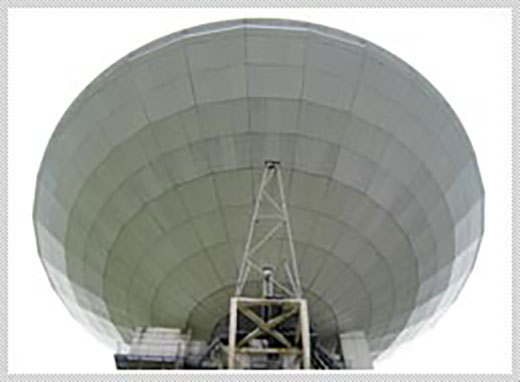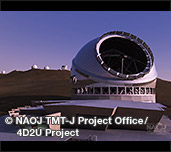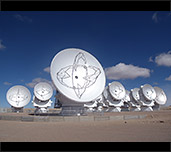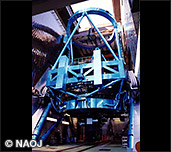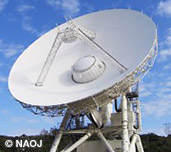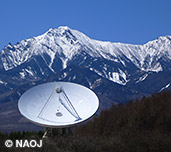Ground SystemsOptical & Radio Telescopes
Mitsubishi Electric contributes to astronomical discovery by producing large-scale radio telescopes utilizing technology for manufacturing antennas, and by producing optical telescopes―exemplified by the "SUBARU TELESCOPE"―using highly precise control technology.
Thirty Meter Telescope (TMT)
Leading the world's astronomy using an ultra-large telescope with an aperture 30m in diameter
Overwhelming performance
TMT will have a resolution about 4 times that of the Subaru Telescope and collect 13 times as much light; hence, its powerful performance will be able to spot an object the size of a firefly on Earth's moon.
Constructed in Hawaii under international collaboration
TMT is currently being built at the summit of Mauna Kea on the island of Hawaii (approx. 4,000m above sea level) with support from the governments of five countries (Japan, US, Canada, China and India). Mitsubishi Electric is responsible for the main "structure" of the telescope.
Giant precision-movement structure
The main structure of telescope will have more than 50 meter in height and width, more than 2,000 ton in weight. It is optimally designed for precise movement in a gigantic structure and to withstand major earthquakes.
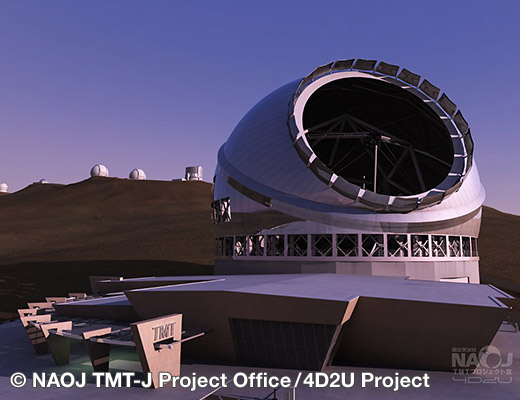
Atacama Large Millimeter/submillimeter Array (ALMA) Antenna
World's largest radio telescope scanning outer space
Joint international project
A total of 66 parabolic antennas are aligned to form a radio telescope located 5,000m above sea level in the Atacama Desert, Chile. Named ALMA, the telescope is jointly operated by Japan, the US and Europe as a global astronomical research project. Mitsubishi Electric manufactured all 16 antennas that Japan provided (four 12m- and twelve 7m-diameter dishes)
Radio telescope using millimeter and submillimeter waves
Thanks to the use of millimeter and submillimeter radio waves, ALMA is capable of observing celestial objects that cannot been seen by the Subaru Telescope or Hubble Space Telescope, which use optical wavelengths and infrared rays.
Large-scale telescope with the world's highest resolution
A total of 66 antennas have been combined to create a giant telescope with a diameter of approximately 18 kilometers. Its resolution is said to be ten times as powerful as the Subaru Telescope and Hubble Space Telescope. If in Tokyo and looking through it, one could see an object the size of a 1-yen coin in Osaka. Its performance is equivalent to the human visual acuity of 6,000.
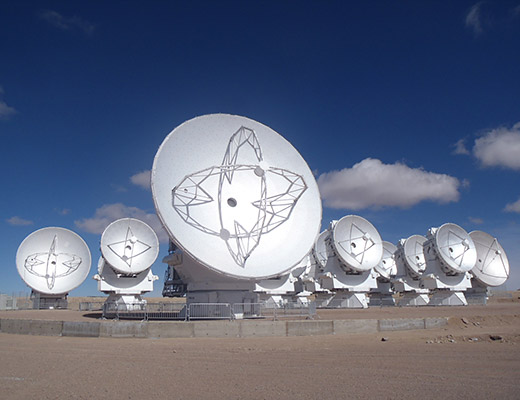
Subaru Telescope
World's largest single-mirror telescope continues to unravel mysteries of the universe
Large-scale infrared optical telescope located at the summit of Mauna Kea on the island of Hawaii
Having a diameter of 8.2m, the world's largest monolithic primary mirror collects the weakest of light from celestial bodies, enabling high-resolution observation. Since its installation in 1999, the Subaru Telescope has provided a number of significant clues to the mysteries of the universe from the peak of Mauna Kea.
Mirror surface distortion corrected instantly
Distortion created when the monolithic primary mirror is tilted is corrected by 261 actuators every 0.1sec in increments of 0.01µm, thereby ensuring the mirror surface is constantly in perfect shape regardless of the telescope angle.
Equipped with the wide-field Hyper Suprime-Cam (HSC)
Observation equipment with a field-of-view seven times that of the previous equipment was installed in July 2013, enabling a wider range of celestial objects to be observed with higher precision.
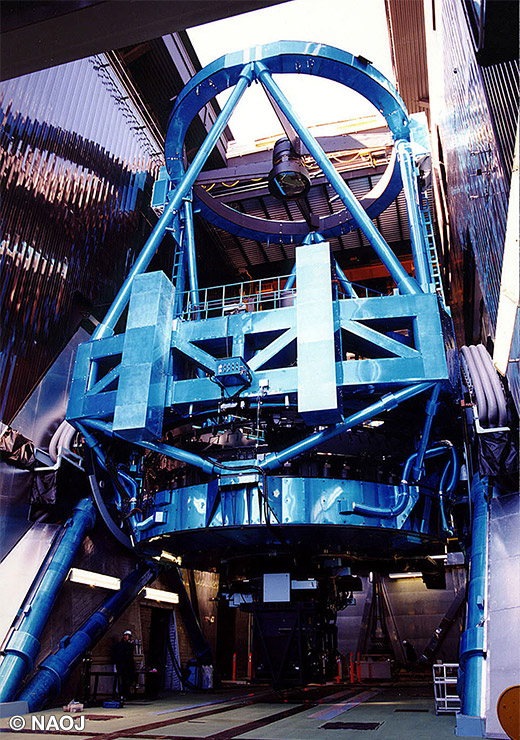
VLBI Exploration of Radio Astrometry (VERA)
Pursuit of radio astronomy using very-long base interferometry (VLBI)
Measuring the distances of celestial objects
The VERA project is designed to reveal the structure of our galaxy by accurately measuring the positions of celestial bodies. This is accomplished using a VLBI observation network and making precise calculations of distances to celestial objects based on stellar parallax.
VLBI: Very Long Baseline Interferometry
Radio telescope with a diameter of 2,300km
The combination of 20m-diameter parabolic antennas located in Mizusawa (Iwate Prefecture), Iriki (Kagoshima Prefecture), Ogasawara (Tokyo) and Ishigaki (Okinawa Prefecture) enable the same performance that a telescope with a 2,300km-diameter could deliver.
"Dual-beam" telescope enables the simultaneous observation of two celestial objects
VERA is the world's first radio telescope to incorporate phase compensation technologies that enable the precise measurement of positions by cancelling out atmospheric fluctuation through the simultaneous observation of two celestial objects.
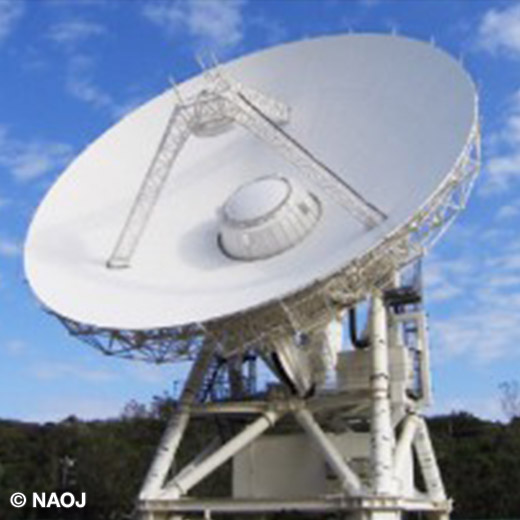
45-meter Radio Telescope at Nobeyama Radio Observatory
The primary mirror of the Nobeyama radio telescope is 45 meters in diameter, and the telescope itself weighs 700 tons. Construction was completed 34 years ago, and it is still one of the world's largest 100 GHz radio telescopes.Radio-wave wavelengths ranging from approximately 2 - 300 mm (frequencies of 1 - 150 GHz) can be observed with the telescope. Observations are being carried out on a vast range of targets, from the atmospheres of nearby planets to protogalaxies at the farthest corners of the universe.
A study by Nobeyama astronomers confirmed for the first time ever that a super-massive black hole exists at the center of a galaxy, astonishing the world.
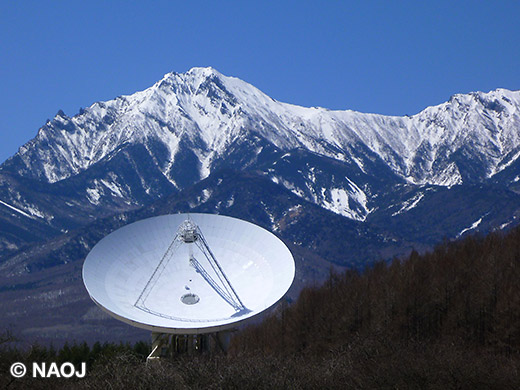
Mitsubishi Electric technologies supporting high mirror accuracy
Due to the radio telescope's size and weight, highly advanced technologies are required to suppress the distortion caused by gravity when the telescope points at a target object. This is where Mitsubishi Electric's unique mirror control technologies are used. By suppressing the deformation generated by the weight of the telescope itself, highly precise observations can be made. In addition, in order to prevent mirror deformation due to heat radiated from the Sun, carbon fiber-reinforced plastic (CFRP)—a material with low thermal expandability, lightweight and strong—is used.
Additionally, thanks to an innovative Mitsubishi Electric air-conditioning system inside the mirror support structure and sun-shading panels behind it, mirror accuracy has been improved even further; the margin of error is successfully reduced to the thickness of a hair (under 90µm)
